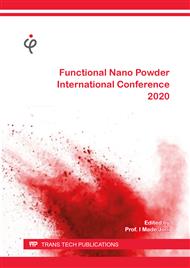[1]
A. Mulyani, A. Rachman, A. Dairah, Penyebaran lahan masam, potensi dan ketersediaanya untuk pengembangan pertanian, Pros. Simp. Nas. Pendayagunaan Tanah Masam. (2010) 23–24.
Google Scholar
[2]
T. Binh, F. Zapata, Standard characterization of phosphate rock samples from the FAO/IAEA phosphate project, Assess. Soil Phosphorus Status Manag. Phosphatic Fertil. to Optim. Crop Prod. IAEA-TECDO (2002) 9–23. https://inis.iaea.org/collection/NCLCollectionStore/_Public/33/019/33019221.pdf?r=1&r=1.
Google Scholar
[3]
P. Sanjotha, P. Mahantesh, C.S. Patil, Isolation and Screening of Efficiency of Phosphate Solubilizing Microbes, Int. J. Microbiol. Res. 3 (2011) 56–58. https://doi.org/10.9735/0975-5276.3.1.56-58.
DOI: 10.9735/0975-5276.3.1.56-58
Google Scholar
[4]
J. Maryanto, Abubakar, Pengaruh Konsentrasi Pupuk Hayati Majemuk dan Batuan Fosfat Alam terhadap Serapan P oleh Tanaman Selada (Latuca sativa L.) di Tanah Andisols, Agrivigor. 3 (2010) 110–117.
DOI: 10.29244/jhi.1.2.66-73
Google Scholar
[5]
B.H. Prasetyo, D.A. Suriadikarta, Karakteristik, Potensi, dan Teknologi Pengelolaan Tanah Ultisol untuk Pengembangan Pertanian Lahan Kering di Indonesia, J. Litbang Pertan. 25 (2006) 39–47. http://pustaka.litbang.deptan.go.id/publikasi/p.3252061.pdf.
DOI: 10.21082/jp3.v39n1.2020.p21-34
Google Scholar
[6]
J.C. Tarafdar, R. Raliya, H. Mahawar, I. Rathore, Development of Zinc Nanofertilizer to Enhance Crop Production in Pearl Millet (Pennisetum americanum), Agric. Res. 3 (2014) 257–262. https://doi.org/10.1007/s40003-014-0113-y.
DOI: 10.1007/s40003-014-0113-y
Google Scholar
[7]
M.C. Derosa, C. Monreal, M. Schnitzer, R. Walsh, Y. Sultan, Nanotechnology in fertilizers, Nat. Nanotechnol. 5 (2010) 91. https://doi.org/10.1038/nnano.2010.2.
DOI: 10.1038/nnano.2010.2
Google Scholar
[8]
Q. Chaudhry, M. Scotter, J. Blackburn, B. Ross, A. Boxall, L. Castle, R. Aitken, R. Watkins, Applications and implications of nanotechnologies for the food sector, Food Addit. Contam. - Part A Chem. Anal. Control. Expo. Risk Assess. 25 (2008) 241–258. https://doi.org/10.1080/02652030701744538.
DOI: 10.1080/02652030701744538
Google Scholar
[9]
M. Garcia, T. Forbe, E. Gonzalez, The dedication of the new cantonal hospital in Liestal., Cienc. e Tecnol. Aliment. 30 (2010) 573–581.
Google Scholar
[10]
L. Xiong, P. Wang, P.M. Kopittke, Tailoring hydroxyapatite nanoparticles to increase their efficiency as phosphorus fertilisers in soils, Geoderma. 323 (2018) 116–125. https://doi.org/10.1016/j.geoderma.2018.03.002.
DOI: 10.1016/j.geoderma.2018.03.002
Google Scholar
[11]
P.M. Kopittke, N.W. Menzies, P. Wang, B.A. McKenna, E. Lombi, Soil and the intensification of agriculture for global food security, Environ. Int. 132 (2019) 105078. https://doi.org/10.1016/j.envint.2019.105078.
DOI: 10.1016/j.envint.2019.105078
Google Scholar
[12]
Y. Zhang, F.S. Chen, X.Q. Wu, F.G. Luan, L.P. Zhang, X.M. Fang, S.Z. Wan, X.F. Hu, J.R. Ye, Isolation and characterization of two phosphate-solubilizing fungi from rhizosphere soil of moso bamboo and their functional capacities when exposed to different phosphorus sources and pH environments, PLoS One. 13 (2018) 1–14. https://doi.org/10.1371/journal.pone.0199625.
DOI: 10.1371/journal.pone.0199625
Google Scholar
[13]
D. Hutagaol, I. Hasrizart, D.A. Sofian, Aplikasi Cendawan Pelarut Fosfat Indigenous Tanah Sawah Meningkatkan Ketersediaan dan Serapan P Padi Sawah, J. Agron. Indones. (Indonesian J. Agron. 45 (2017) 9–13. https://doi.org/10.24831/jai.v45i1.13648.
DOI: 10.24831/jai.v45i1.13648
Google Scholar
[14]
R. Teodosieva, D. Bojinova, Biodecomposition of Jordan phosphorite by Phosphate-Solubilizing Fungi, Brazilian J. Chem. Eng. 33 (2016) 1–11. https://doi.org/10.1590/0104-6632.20160331s00003267.
DOI: 10.1590/0104-6632.20160331s00003267
Google Scholar
[15]
E. Afif, A. Matar, J. Torrent, Availability of Phosphate Applied to Calcareous Soils of West Asia and North Africa, Soil Sci. Soc. Am. J. 57 (1993) 756–760. https://doi.org/10.2136/sssaj1993.03615995005700030022x.
DOI: 10.2136/sssaj1993.03615995005700030022x
Google Scholar
[16]
Haryanto, K. Idris, R.I. Kawalusan, Pengaruh Pupuk Fosfat Alam Pada Tanah Masam Terhadap Pertumbuhan Jagung Serta Serapan N-ZA dan N-Urea, J. Ilm. Apl. Isot. Dan Radiasi. 4 (2008) 130–142.
DOI: 10.30598/a.v1i2.286
Google Scholar
[17]
P.D.S.U. Kumari, C.M. Nanayakkara, Phosphate-solubilizing fungi for efficient soil phosphorus management, Sri Lanka J. Food Agric. 3 (2017) 1. https://doi.org/10.4038/sljfa.v3i2.46.
DOI: 10.4038/sljfa.v3i2.46
Google Scholar
[18]
S.M. Singh, L.S. Yadav, S.K. Singh, P. Singh, P.N. Singh, R. Ravindra, Phosphate solubilizing ability of two arctic Aspergillus niger strains, Polar Res. 30 (2011). https://doi.org/10.3402/polar.v30i0.7283.
DOI: 10.3402/polar.v30i0.7283
Google Scholar
[19]
P.J. Artha, H. Guchi, P. Marbun, Efektifitas Aspergiluss niger dan Penicillium sp dalam meningkatkan ketersediaan Fosfat dan pertumbuhan tanman jagung pada tanah Andisol, J. Online Agroekoteknologi. 1 (2013) 1277–1287.
DOI: 10.29244/jhi.1.2.66-73
Google Scholar
[20]
R. Devnita, B. Joy, M. Arifin, R. Hudaya, N. Oktaviani, Application of nanoparticle of rock phosphate and biofertilizer in increasing some soil chemical characteristics of variable charge soil, AIP Conf. Proc. 1927 (2018). https://doi.org/10.1063/1.5021220.
DOI: 10.1063/1.5021220
Google Scholar
[21]
H. Tributsch, Direct versus indirect bioleaching, Hydrometallurgy. 59 (2001) 177–185. https://doi.org/10.1016/S0304-386X(00)00181-X.
DOI: 10.1016/s0304-386x(00)00181-x
Google Scholar
[22]
X. Wang, C. Wang, J. Sui, Z. Liu, Q. Li, C. Ji, X. Song, Y. Hu, C. Wang, R. Sa, J. Zhang, J. Du, X. Liu, Isolation and characterization of phosphofungi, and screening of their plant growth-promoting activities, AMB Express. 8 (2018) 1–12. https://doi.org/10.1186/s13568-018-0593-4.
DOI: 10.1186/s13568-018-0593-4
Google Scholar
[23]
X. Zhou, S. Wan, Y. Luo, Source components and interannual variability of soil CO2 efflux under experimental warming and clipping in a grassland ecosystem, Glob. Chang. Biol. 13 (2007) 761–775. https://doi.org/10.1111/j.1365-2486.2007.01333.x.
DOI: 10.1111/j.1365-2486.2007.01333.x
Google Scholar
[24]
T.A. Spedding, C. Hamel, G.R. Mehuys, C.A. Madramootoo, Soil microbial dynamics in maize-growing soil under different tillage and residue management systems, Soil Biol. Biochem. 36 (2004) 499–512. https://doi.org/10.1016/j.soilbio.2003.10.026.
DOI: 10.1016/j.soilbio.2003.10.026
Google Scholar
[25]
F. Raiesi, M. Ghollarata, Interactions between phosphorus availability and an AM fungus (Glomus intraradices) and their effects on soil microbial respiration, biomass and enzyme activities in a calcareous soil, Handb. Environ. Chem. Vol. 5 Water Pollut. 50 (2006) 413–425. https://doi.org/10.1016/j.pedobi.2006.08.001.
DOI: 10.1016/j.pedobi.2006.08.001
Google Scholar
[26]
Q. Yang, X. Wang, Y. Shen, J.N.M. Philp, Functional diversity of soil microbial communities in response to tillage and crop residue retention in an eroded Loess soil, Soil Sci. Plant Nutr. 59 (2013) 311–321. https://doi.org/10.1080/00380768.2013.775004.
DOI: 10.1080/00380768.2013.775004
Google Scholar
[27]
S. Wakelin, C. Mander, E. Gerard, J. Jansa, A. Erb, S. Young, L. Condron, M. O'Callaghan, Response of soil microbial communities to contrasted histories of phosphorus fertilisation in pastures, Appl. Soil Ecol. 61 (2012) 40–48. https://doi.org/10.1016/j.apsoil.2012.06.002.
DOI: 10.1016/j.apsoil.2012.06.002
Google Scholar


